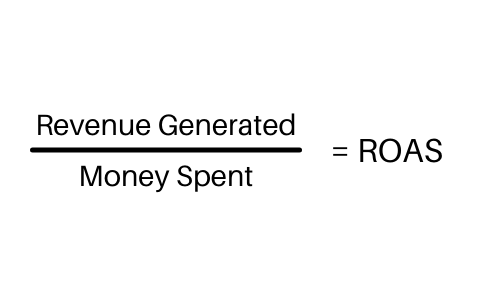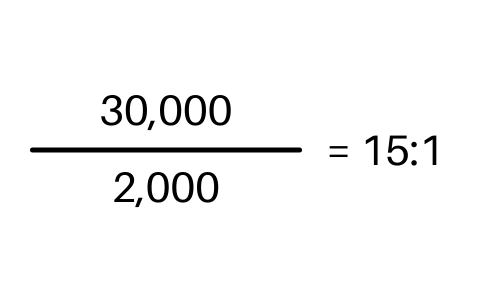What is Return on Ad Spend (ROAS)?
Return On Ad Spend (ROAS) is a metric that measures the revenue earned for every dollar spent on advertising. This metric is essential to optimizing digital ad campaigns, as it is one of the most effective ways to measure the performance of individual advertisements, designs, and copy.
Return on ad spend is typically expressed as a ratio. For example, a 3:1 ROAS would mean that the advertiser made $3 in revenue for every $1 spent on the ad.
How is ROAS Calculated?
ROAS is calculated very simply. Take the total amount of revenue generated from an advertisement or campaign, and divide it by the total amount spent on it like the figure below.

For example, if you spent $2,000 on an ad campaign which generated $30,000, then your calculation would look something like this:

After you divide $30,000 by $2,000 you’re left with 15. Therefore, your return on ad spend would be 15:1, or 15 dollars in revenue for every dollar spent on the ads.
How to Improve ROAS
ROAS is a great metric to help you understand how effective individual ads are, and to get a sense of how your audience is responding to the design, copy, or product.
There are many ways to optimize ads for performance, but below are a few of the most impactful ways that you can start improving your return on ad spend today.

A/B Test Ad Variants
Split testing your ads is one of the leading ways to improve your design and copy, and narrow down what your audience responds well to.
In short, A/B Testing is the act of displaying two versions of an ad, one version with one element changed along with the original to the same audience in order to identify if the change in the element improves performance.
For example, you could A/B test two two ads with the exact same product, picture, and design, but display them with different descriptions or text copy.
With this test, you will be able to clearly tell the difference in performance and engagement with the descriptions alone, as all other elements are identical.
By isolating an element to test, marketers are able to improve ad performance based on true data and insight, enabling them to make more accurate adjustments and improve overall ROAS. Changing multiple elements at a time would result in being unable to pinpoint which was the real driver of the improved performance.
Optimize Ad Spend With Optily
Using Optily to optimize ad spend enables marketers to see all of their campaign managers in one place, and use actionable insights and automation to improve return on ad spend.
The platform automatically combines your ad accounts into an easy funnel strategy for seamless management. Optily’s platform delivers deep, actionable insights from macro to micro, helping marketers improve everything from individual ad copy to funnel stages as a whole.
By leveraging the platform’s recommendations and automations, marketers can better get a sense of their ad spend, adjust spending between platforms seamlessly, and automate small adjustments and CPC optimization.
Onsite Conversion Optimization
Another effective way to improve your return on ad spend is by converting more of your website visitors into customers. You can do this by leveraging tools like Justuno to improve the onsite funnel from acquisition to conversion.
Marketers have used onsite tools such as promotions, product recommendation engines, and onsite messaging to increase their conversion rate and average order value (AOV) since the beginning of Ecommerce.
As it relates to return on ad spend, a good conversion rate can drastically improve your take home revenue by increasing the worth of each order, and by pulling in more orders from the same amount of traffic.
For example, if your ads are pulling in 10,000 visitors per month and your conversion rate is 3%, then you could project about 300 of your visitors becoming customers.
Let’s say your average order value is $50. At this rate, your ads are making about $15,000 in revenue each month. If we assume it costs you $5,000 to run those ads, then your ROAS would be 3:1 – not bad!
Now let’s say you start running promotions on your website, and that bumps up your conversion rate to a still-modest 5%. With the same amount of visitors from your ads with the exact same ad spend, your ads would now be pulling in $25,000 per month, resulting in a 5:1 ROAS.
As you can see, small improvements in conversion rate can compound into massive results in the end game even with basic (mostly free) tools, which for brands like yours spells much more money. Focus on capturing these leads, so even if this first visit doesn’t result in a sale you can continue the conversation and ultimately convert the traffic you’ve already paid for.
Some strategies using onsite messaging and promotions to improve ROAS are:
- Welcome pop-ups targeting campaign UTMs to reiterate the offer & messaging that drove their initial interest
- Intelligent product recommendations based on the products featured in the ad campaigns
- Return visitors pop-ups targeting paid ad traffic revisiting your website for later funnel messaging designed to convert
- And so much more.
Conclusion
Improving return on ad spend should be a very important factor in any brand’s digital marketing strategy. Although it can be complicated, iit does not have to start out that way, and in fact, some of the most effective methods happen to be the simplest.
Hopefully by now you have a good idea of where to start in improving ROAS and increasing the performance of your marketing channels.
Be sure to check out Justuno’s free trial to get started with onsite optimization tools, as well as Optily’s free trial to begin automating and optimizing your ad spend directly.





